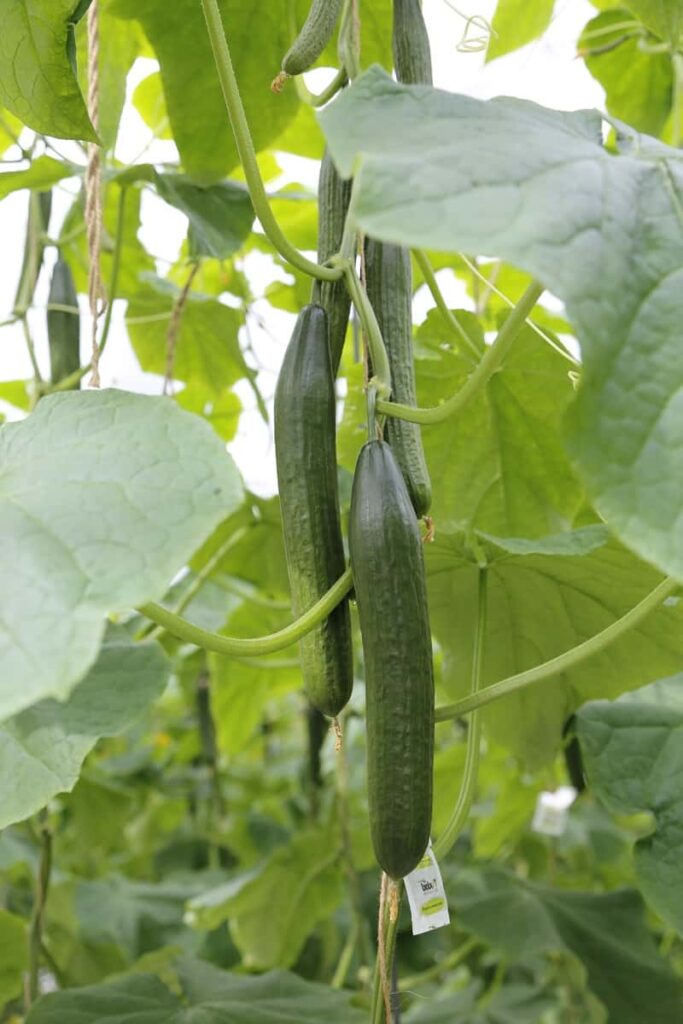Are you an urban gardener looking for a new challenge of growing cucumbers vertically? Then vertical cucumber farming is the best option. It is a great way to maximize your space, but it’s also a fun and unique way to grow your food. While it may seem daunting initially, vertical cucumber farming is quite simple.
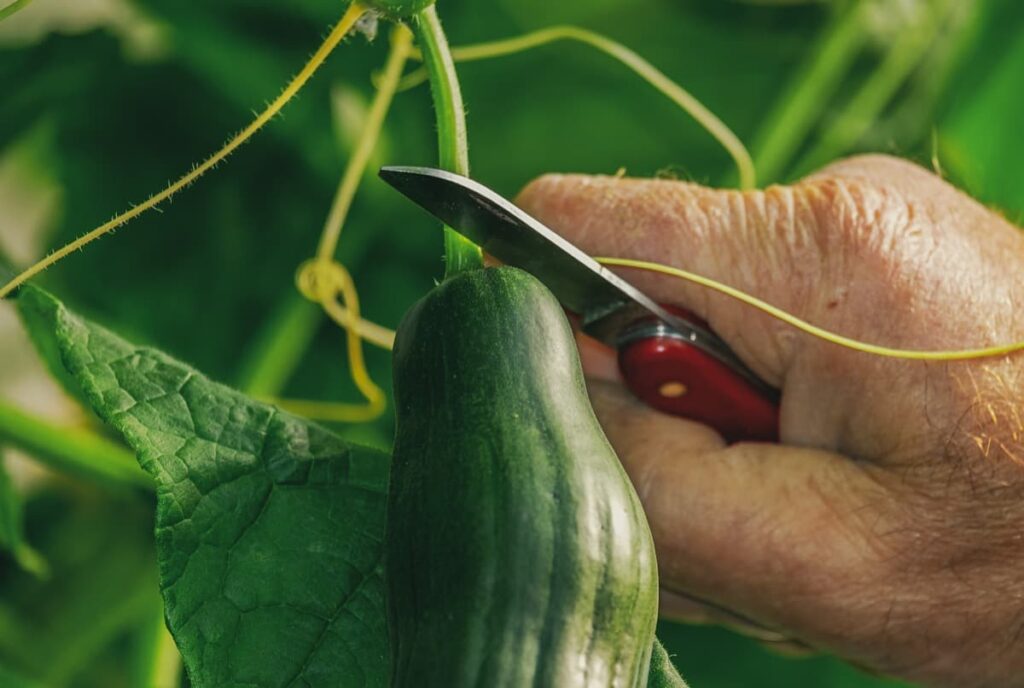
With some planning and basic materials, you can successfully grow your cucumbers in limited space at home. This blog post will explore the best clever ways to get from seed to table with vertical cucumber farming. From planting tips to harvesting and beyond, we’ve got you covered. So if you’re ready to take your gardening game to the next level, read on.
Vertical cucumber farming for the urban gardener
If you live in a small space or want to maximize your yield in the minimum space, then vertical cucumber farming is for you! Cucumbers are a great crop to grow vertically because they are relatively lightweight and tend to sprawl. You can grow cucumbers vertically in several ways, from simple trellises to more elaborate structures. One of the simplest ways to get started with vertical cucumber farming is to build a simple trellis out of wood or metal.
You can make this happen with the two pieces of wood together at an angle or tying pieces of string or wire between two points. Then, train your cucumber vines up the trellis as they grow. You can also buy pre-made trellises at most garden stores. Another option for vertical cucumber farming is to build an A-frame structure out of wood or PVC pipe.
This structure is slightly more complex than a trellis but will support your cucumber vines on all sides. To build an A-frame, start by cutting two pieces of wood or PVC pipe to the same length. Then, nail or screw them at the top to form an inverted “V” shape. Next, drive stakes into the ground on either side of the A-frame and tie them securely to the base.
Climbing cucumber varieties
There are many varieties of climbing cucumber, each with its unique flavor and characteristics. Some of the most popular varieties include:
- Armenian cucumbers: These have a slightly bitter taste and are often used in salads or as a pickling cucumber.
- Persian cucumbers: These are milder in flavor than Armenian cucumbers and are more often used in salads or as a garnish.
- English cucumbers: These have a very mild flavor and are often used in sandwiches or as a garnish.
In case you missed it: How to Protect Cucumber and Squash Plants from Powdery Mildew: Causes, and Treatment
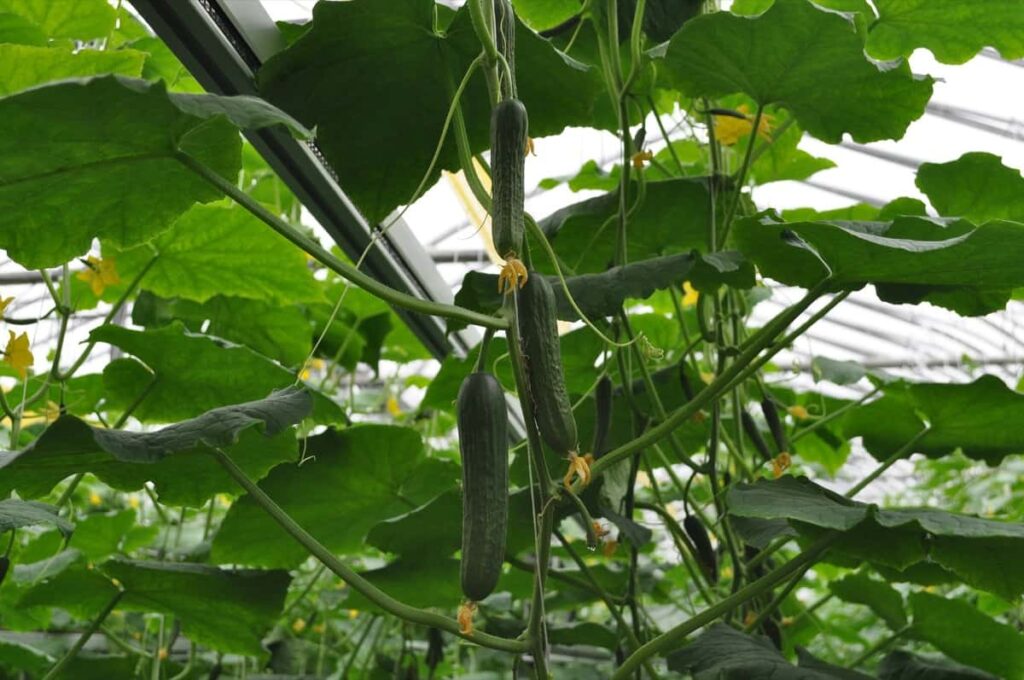
Planting cucumber seeds
Climbing cucumber seeds can be planted directly in the ground or pots. If starting the seeds indoors, plant them about 45 days before the last frost date for your area. When planting the seeds outdoors, plant them about 15 days before the last frost date for your area.
Caring for your cucumber plants
Cucumber plants need full sun and well-drained soil to thrive. Water the plants regularly, keeping the leaves dry to prevent fungal diseases. Fertilize the plants with a balanced fertilizer every two weeks to encourage growth and fruiting.
Harvesting cucumbers
Cucumbers can be harvested when they are about 6 inches long. To harvest, cut the stem just above where the fruit is attached to.
The best soil to grow cucumbers vertically
If you want to grow cucumbers vertically, you must choose the best soil to get more yields. The best soil for vertical cucumber farming is a light, sandy loam. This soil is easy to work with and drains well, which is vital for cucumbers. It also warms up quickly in the spring, which is suitable for cucumber plants.
Cucumber seed germination in vertical farming
Cucumber seed germination is a process that starts with soaking the seeds in water overnight. After soaking, the seeds are placed in a planting medium, such as vermiculite or perlite, and covered with plastic wrap to retain moisture. The seeds should be kept at a temperature of 70 to 85 degrees Fahrenheit until they germinate, which usually takes 5 to 7 days. Once the seeds have germinated, they can be transplanted into individual pots or cells. The plants should be kept at 60 to70 degrees Fahrenheit and given plenty of light.
Once the plants have grown to several inches, they can be transferred to a vertical growing system. Vertical cucumber farming is an efficient way to grow cucumbers in an urban setting. Cucumbers can be grown in a small footprint by utilizing vertical space while still producing a large yield. When grown vertically, cucumbers also require less water and fertilizer than when grown horizontally. If you are interested in growing cucumbers vertically, there are some things you should consider:
- Choose a variety of cucumber that is well suited for growing in containers or has been bred for vertical production.
- Ensure you have a well-draining growing medium and adequate ventilation to prevent fungal diseases.
- Provide support for the cucumbers as they grow by training them onto lattices or trellises.
How do you train a cucumber vertically?
Training them to grow vertically is an excellent idea if you have a small space in your urban garden or want to get creative with your cucumber plants. Not only does it save space, but it also makes for a more efficient and bountiful harvest.
- Choose a trellis or other support structure that is at least 6 feet tall and made of sturdy material. You can purchase a pre-made trellis or build one using wood or metal posts and wire mesh.
- Plant your cucumber seeds or seedlings at the base of the trellis, spacing them about 12 inches apart. If you’re using seedlings, be sure to transplant them carefully so as not to damage the roots.
- As the cucumber plants grow, direct their vines up the trellis by gently tying them to the support structure with soft fabric strips or twine. Be careful not to damage the stems as you tie them.
- Allow the cucumbers to grow up the trellis until they reach the top. Once they start producing fruit, you may need to provide additional support for the weight of the cucumbers by attaching individual branches to the trellis with fabric strips or twine.
- Enjoy your vertical cucumber farm! Harvest the cucumbers when they’re ripe.
In case you missed it: Top 20 Steps to Boost Cucumber Yield: How to Increase Cucumber Size, Quality, and Production
Vertical cucumber trellis
If you’re an urban gardener with limited space, you may think that growing cucumbers is out of the question. But with ingenuity and clever trellising, you can enjoy fresh, delicious cucumbers right in your backyard. One great way to maximize your cucumber-growing space is to build a vertical cucumber trellis. This simple structure will allow your plants to climb upwards, giving you more room to grow other vegetables or flowers beneath. Plus, it’ll make harvesting your crop a breeze.
How to build a vertical cucumber trellis in just a few easy steps
- Choose a sunny spot in your garden for your trellis. Cucumbers need at least six hours of sunlight daily to produce bumper crops.
- Drive four stakes into the ground soil at the corners of your chosen spot. Make sure they’re securely anchored so they won’t tip over when your plants start to climb.
- Attach chicken wire or fencing material to the stakes, creating a square or rectangular frame. The wire should be taut so that your cucumbers have something firm to grab onto as they grow up.
- Plant your cucumber seeds or seedlings at the base of the trellis. Water them well and keep them moist throughout the growing season.
- As your cucumbers start to vine, train them onto the chicken wire.
Vertical cucumber spacing
To get better yield and fruit quality from your cucumber plants, it’s important to space them out correctly. When planting cucumbers in a vertical garden, you’ll need to space the plants about 8-10 inches apart. This will give the plants enough room to grow and produce plenty of fruit.
If you’re growing cucumbers vertically on a trellis or other support structure, make sure that the structure is strong enough to support the weight of the plant and fruit. Also, keep an eye on the cucumbers as they grow, as they can become heavy and cause the structure to collapse if not supported properly.
How to grow cucumbers on a trellis
Assuming you have planted your cucumber seeds or seedlings in soil, you will need to support the plants as they grow. Cucumbers are climbing plants and naturally want to grow up and over anything in their way. A trellis is an ideal support structure as it provides a vertical surface for the plant to climb while keeping the fruits off the ground, where they can rot or be eaten by pests.
How to install a trellis?
- Drive two stakes into the ground on either side of your cucumber plants.
- Make sure the stakes are at least four feet tall so that the cucumbers have plenty of room to grow.
- Attach some netting or string between the two stakes, creating a surface for the cucumbers to climb. You can also buy pre-made metal or plastic trellises that you can insert into the ground next to your plants.
Once your cucumbers start growing, train them to climb up the trellis by gently twining them around the netting or string. Do this a few times throughout the season as they grow. Be careful not to damage the plants as you do this. With proper training, your cucumbers should stay neatly contained on the trellis and stay off the ground, where they can rot or be eaten by pests.
The best fertilizer for your cucumbers plants
When choosing the best fertilizer for your cucumbers, there are a few things to consider. The first is the type of cucumber plant you have. There are two main types of cucumbers, slicing, and pickling. Each type has different fertilizer requirements. Slicing cucumbers need a lot of nitrogen to produce big, juicy fruits.
Choose the fertilizer with a high first number in the N-P-K ratio (nitrogen-phosphorus-potassium). Pickling cucumbers need less nitrogen and more potassium to produce crisp fruits. Look for a fertilizer with a lower first and a higher third number in the N-P-K ratio. The second thing to consider is the stage of growth your cucumber plants are in. Cucumber plants have different fertilizer needs during different stages of growth.
In case you missed it: Hydroponic Cucumber Farming, Planting Procedure
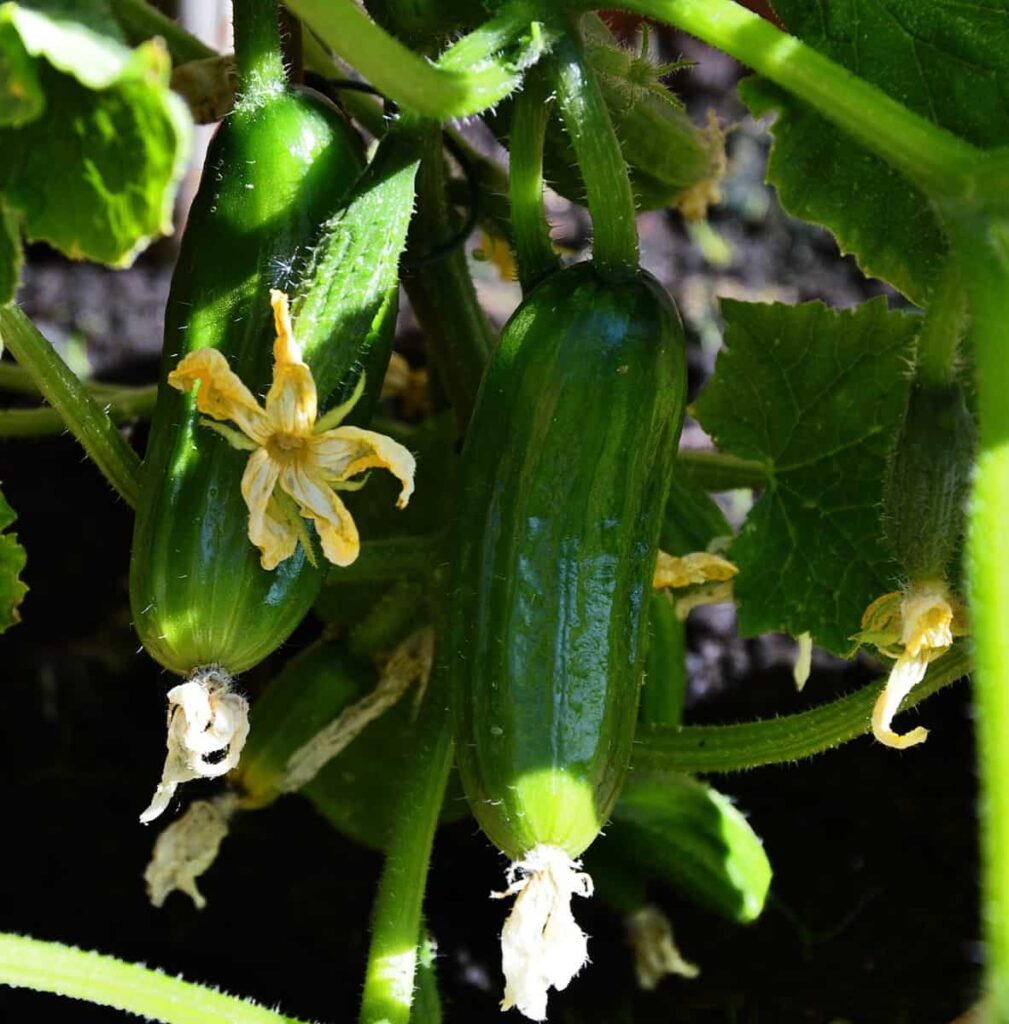
For example, young plants need more phosphorus for strong root growth, while mature plants need more potassium for fruit production. The best way to ensure your cucumber plants get the nutrients they need is to use a balanced fertilizer with an N-P-K ratio appropriate for the type of cucumber plant you have and the stage of growth your plants are in. You can also use compost or manure to supplement your fertilizer program.
Cucumber plant care in vertical growing
To get more yields from your cucumber plants, it is vital to take care of them significantly and adequately when growing vertically. Here are some ways and techniques on how to do so:
- Water regularly, especially during hot weather.
- Apply a balanced fertilizer every few weeks.
- Train the vines up your support structure using ties or clips.
- Pinch off the tips of the vines periodically to encourage bushier growth.
- Harvest often to keep the plants producing.
How tall do cucumber plants grow vertically?
Cucumber plants are typically grown vertically to save space. They can grow quickly up to six feet tall, but the average height is between 3-4 feet. When grown vertically, cucumber plants require less water and fertilizer than when grown horizontally. The plant’s fruits are less likely to rot or be affected by pests and diseases.
Best cucumber planting strategies for vertical gardening
If you have a small space but still want to enjoy your vegetables, vertical cucumber farming may be for you. While it takes a little more effort than traditional gardening, the results are worth it. Plus, it’s a great way to get your kids involved in gardening! Here are some tips to get started:
- Choose the right cucumber plant. There are wide varieties of cucumbers, so research to find one that will work well for vertical gardening. Some good choices include ‘Bush Pickle,’ ‘Dwarf White,’ and ‘Patio Pride.’
- Start your plants from seed. Cucumber seeds can be started indoors about six weeks before the last frost time in your region. Start sowing the seeds in small pots filled with potting soil, and places them in a sunny spot. Make sure to keep the plant base soil moist but not waterlogged, and fertilize every other week with a half-strength of liquid fertilizers solution
- When it’s time to transplant your cucumber plants outdoors, choose a sunny spot with well-drained soil. If you’re growing cucumbers on a trellis or other support structure, make sure it’s sturdy and can hold up to the weight of the plants (and fruits!).
- Once your plants are in place, water them deeply and regularly (about once in 7 days). Add a layer of organic mulch around the base of each plant.
Making cucumbers grow faster
You can do a few things if you want cucumbers to grow faster. First, ensure you have a good quality soil mix and that your planting bed is well-drained. Cucumbers like warm weather, so if you can provide them with a bit of extra warmth early on in the season, they will tend to grow faster. The best tip to do this is to use black plastic mulch or row covers. You can also try using a high-nitrogen fertilizer when planting cucumber seeds or seedlings.
This will help the plants with a boost of nutrients that will help them grow more quickly. Be careful not to overdo it, though, as too much nitrogen can produce fewer fruits. Finally, make sure you keep the plants well-watered throughout the growing season. Cucumbers need plenty of water to produce lots of fruits, so ensure they never get too dry. If possible, it is recommended to water them at the plant basin rather than from above to avoid any fungal diseases.
Pruning vertical cucumber plants
Pruning cucumber plants are a vital part of keeping them healthy and productive. When pruning, it’s essential to remove any dead or dying leaves, as well as any that are diseased or damaged. It would be best if you also pruned off any side shoots growing from the main stem, as these will take away energy from the plant that could be used for fruit production.
If you’re growing cucumbers vertically, you’ll need to prune the plants differently to encourage them to grow up rather than out. To do this, pinch out the tips of the main stems once they’ve reached around 30cm in length. This will encourage the plant to put all its energy into producing longer stems rather than lateral growth.
Greenhouse cucumber vertical farming
Most people think of cucumbers as a horizontal crop, sprawling across the ground in a large, green mass. But did you know that cucumbers can also be grown vertically? Vertical cucumber farming is a type of agriculture where cucumbers are grown on vertically oriented structures, often in towers or shelves.
In case you missed it: Organic Cucumber Farming In Greenhouse
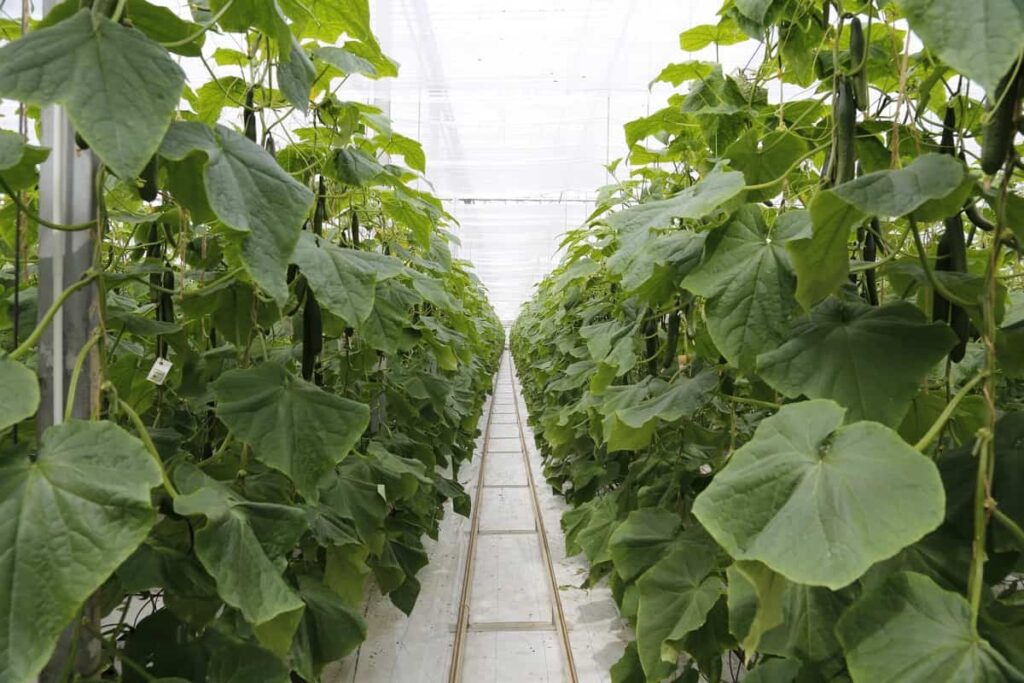
This method has several benefits over traditional horizontal cucumber farming, including higher yields, less water and land usage, and more manageable pest and weed control. If you live in an urban area with limited space for gardening, vertical cucumber farming may be the perfect solution. With creativity, you can grow delicious cucumbers right in your backyard!
Hydroponic cucumber vertical farming
Cucumbers are one of the popular vegetables to grow hydroponically. They are fast-growing, easy to care for, and produce an abundant crop. Cucumbers can be grown in many ways, but vertical cucumber farming is incredibly efficient for the urban gardener. Vertical cucumber farming involves training the plants to grow up a support structure instead of outwards across the ground.
This allows you to grow more cucumbers in a smaller space, which is ideal if you have a small garden space. Vertical cucumber farming also protects your cucumbers from pests and diseases affecting ground-grown plants. There are a few standard things to remember when setting up a vertical cucumber farm. First, choose a suitable support structure for your plants. This could be anything from metal trellises to PVC pipes anchored into the ground.
Make sure that whatever you use is should be strong enough to support your cucumber’s weight as they grow. Next, you’ll need to select a growing medium for your plants. Hydroponic systems usually use gravel or clay pellets, but you can also use potting mix or vermiculite. Whichever growing medium you choose, ensure it has good drainage so excess water can easily escape. Once you’ve set up your support structure and chosen your growing medium, it’s time to plant your cucumber seeds or seedlings.
Cucumber trellis ideas for small spaces
If you’re tight on space in your urban garden, don’t despair – there are plenty of ways to grow cucumbers vertically, so you can still enjoy a bountiful harvest. Here are some clever cucumber trellis ideas for small spaces:
- Use a simple trellis or fence. If you have a few feet of space available, train your cucumber plants up a trellis or fence. You can buy pre-made trellises at most garden stores or build your own using some basic woodworking skills.
- Get creative with recycled materials. Have some old pallets or shipping crates lying around? Put them to good use as impromptu cucumber trellises! Just stack them up and nail them together, then train your plants to climb.
- Go vertical with PVC pipe. For a super-simple DIY trellis, screw some lengths of PVC pipe together into a pyramid shape. Your cucumbers will have no problem climbing up this lightweight structure, and you can easily break it down and store it away when the season is over.
- Make a teepee out of bamboo poles. This classic kid’s play structure also makes an excellent cucumber trellis! Just drive some bamboo poles into the ground in a teepee shape, then tie them together at the top and train your plants to climb up the sides
In case you missed it: Cucumber Farming; Planting; Care; Harvesting Guide
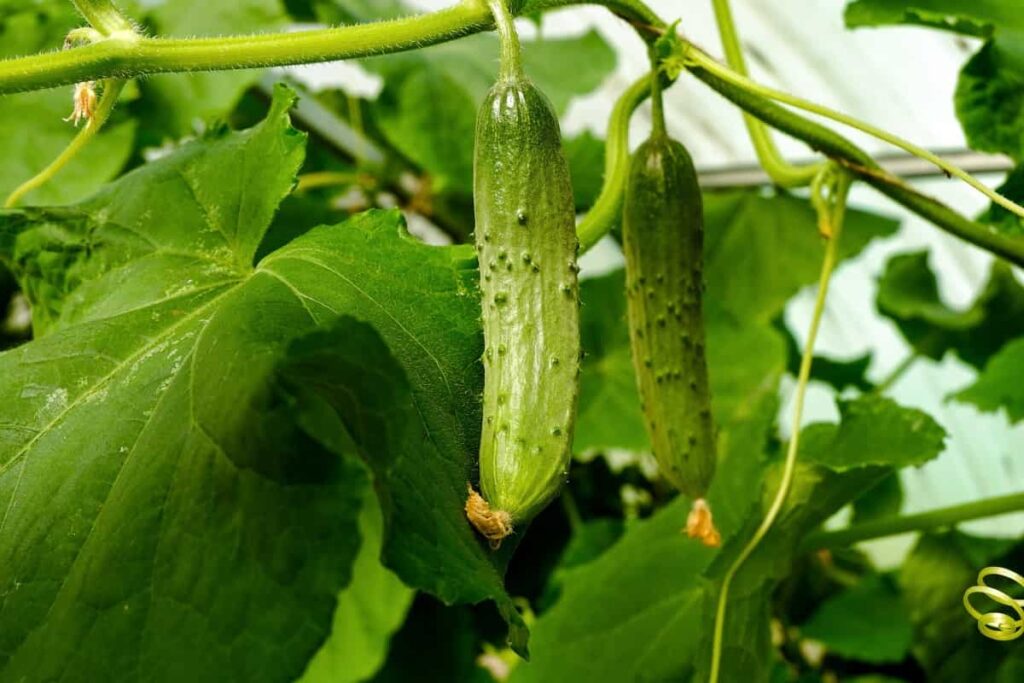
Growing cucumbers vertically on a string
If you have limited garden space or want to try something different, then vertical cucumber farming could be for you. Cucumbers are versatile vegetables used in salads, sandwiches, and even garnish. When grown vertically, they also look pretty impressive. Here are some ideas, techniques, and tips on how to get started with vertical cucumber farming:
- Choose a suitable cucumber variety. Some varieties are better suited to growing vertically than others. Do some research to find out which ones will work best in your climate and space restrictions.
- Train the cucumber plants up a string or trellis. This will help them to grow straight and avoid any damage from the weight of the fruit.
- Water regularly and fertilize accordingly. Cucumbers need plenty of water to produce juicy fruit, so make sure they are well-hydrated. A balanced fertilizer will also give them the nutrients they need to thrive.
- Harvest when the cucumbers are ripe. Check them regularly so that you don’t miss the optimum harvesting time. Cut the stem close to the fruit so that it doesn’t damage the plant when picking it off the string or trellis.
Six tips to grow cucumbers vertically
- Start with high-quality seeds from a reputable source.
- Sow the seeds in well-drained, nutrient-rich soil.
- Water the plants regularly, especially during hot weather.
- Train the plants to grow vertically on supports such as trellises or cages.
- Pinch off the tips of the main stems once the plants have reached the desired height to encourage lateral branch growth.
- Harvest the cucumbers when they are ripe and enjoy them fresh from the vine!
Watch this video for Boosting Cucumber Yield:
Conclusion
With vertical cucumber production, one can expect very good yields in small spaces. You can expect greenhouse cucumber vertical farming would be the future.
- Economical Aquaculture: A Guide to Low-Budget Fish Farming
- 15 Common Planting Errors That Can Doom Your Fruit Trees
- How to Make Houseplants Bushy: Effective Tips and Ideas
- Innovative Strategies for Boosting Coconut Pollination and Yield
- Pollination Strategies for Maximum Pumpkin Yield
- The Complete Guide to Chicken Fattening: Strategies for Maximum Growth
- Natural Solutions for Tulip Problems: 100% Effective Remedies for Leaf and Bulb-Related Issues
- Revolutionizing Citrus Preservation: Towards a Healthier, Greener Future
- Natural Solutions for Peony Leaf and Flower Problems: 100% Effective Remedies
- Maximizing Profits with Avocado Contract Farming in India: A Comprehensive Guide
- Natural Solutions for Hydrangea Problems: 100% Effective Remedies for Leaf and Flowers
- The Ultimate Guide to Choosing the Perfect Foliage Friend: Bringing Life Indoors
- From Sunlight to Sustainability: 15 Ways to Use Solar Technology in Agriculture
- The Ultimate Guide to Dong Tao Chicken: Exploring from History to Raising
- The Eco-Friendly Makeover: How to Convert Your Unused Swimming Pool into a Fish Pond
- Mastering the Art of Delaware Chicken Farming: Essentials for Healthy Backyard Flocks
- 20 Best Homemade Fertilizers for Money Plant: DIY Recipes and Application Methods
- How to Craft a Comprehensive Free-Range Chicken Farming Business Plan
- Brighten Your Flock: Raising Easter Egger Chickens for Beauty and Bounty
- How to Optimize Your Poultry Egg Farm Business Plan with These Strategies
- Subsidy for Spirulina Cultivation: How Indian Government Schemes Encouraging Spirulina Farmers
- Ultimate Guide to Raising Dominique Chickens: Breeding, Feeding, Egg-Production, and Care
- Mastering the Art of Raising Jersey Giant Chickens: Care, Feeding, and More
- Ultimate Guide to Raising Legbar Chickens: Breeding, Farming Practices, Diet, Egg-Production
- How to Raise Welsummer Chickens: A Comprehensive Guide for Beginners
- How to Protect Indoor Plants in Winter: A Comprehensive Guide
- Ultimate Guide to Grow Bag Gardening: Tips, Tricks, and Planting Ideas for Urban Gardeners
- Guide to Lotus Cultivation: How to Propagate, Plant, Grow, Care, Cost, and Profit
- Agriculture Drone Subsidy Scheme: Government Kisan Subsidy, License, and How to Apply Online
- Ultimate Guide to Raising Araucana Chickens: Breed Profile, Farming Economics, Diet, and Care
- Bringing Hydroponics to Classroom: Importance, Benefits of Learning for School Students
- Ultimate Guide to Raising Polish Chickens: Breed Profile, Farming Economics, Diet, and Care
- Ultimate Guide to Raising Australorp Chickens: Profile, Farming Economics, Egg Production, Diet, and Care
- Silkie Chicken Farming: Raising Practices, Varieties, Egg Production, Diet, and Care
- Sussex Chicken Farming: Raising Practices, Varieties, Egg Production, Diet and Care
- Homemade Feed Formulations for Livestock: Discover Cost-effective Starter to Finisher Feed Recipes
